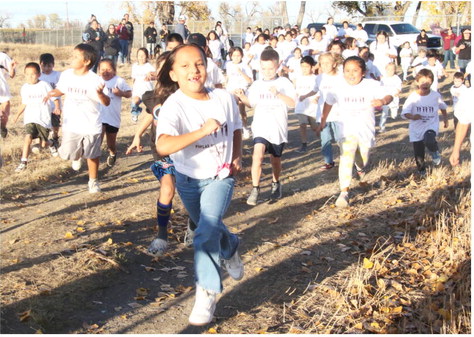Deer, Elk Surveys Show Mixed Results
Biologists conducting spring deer and elk surveys found some areas with improved herd growth and some areas with lower recruitment due to poor habitat conditions and disease.
During the spring season, FWP wildlife staff get a pulse on deer and elk numbers by conducting aerial spring trend surveys or green-up flights across the state. These flights occur in the same areas year after year so biologist can understand population trends.
During the flights, staff count the total number of deer and elk they see and classify fawns/calves and adults to determine recruitment rates. Fawns/calves counted during spring surveys have survived their first winter and are recruited into the population. The fawn/calf count also provides a critical measure for population – the ratio of young to adults. The data gathered from these surveys are then used to adjust any antlerless B licenses prior to the drawing.
Long-term datasets for deer and elk let FWP determine if populations are increasing, decreasing or remaining stable and adjust antlerless B licenses as needed. For antlerless B licenses for both elk and deer, the Fish and Wildlife Commission approves a quota range for each hunting district, or in some cases a region. FWP adjusts the B license quota within that range as necessary to protect herd numbers.
Here is a rundown by area for spring counts and license quota adjustments: Northeast Montana - Region 6 Mule Deer What we saw: Total mule deer numbers on post-season surveys were 21 percent below average, and spring surveys were 16 percent below average. Both represent a significant decrease from both the 2023 surveys and the historic high population observed in 2021. Fawn to doe ratios improved in 2024 to 59 fawns to 100 does, which is 11 percent above average and 41 percent higher than observed in 2023.
What we did: We reduced Antlerless Mule Deer B License quota levels by 3,375 (54 percent) across the region, from 6,200 in 2023 to 2,825 in 2024.
Why we did it: Much of the region is managing antlered harvest within standard management objectives but has restricted Mule Deer B Licenses for antlerless mule deer at levels comparable to the 43 percent of the 10-year average. In other words, the number of antlerless licenses are quite low in comparison with historical numbers.
The results we are expecting: We expect an estimated 1,158 antlerless mule deer harvested with these licenses. In addition to a reduction in antlerless mule deer harvest, we also expect mule deer populations to respond positively to improved habitat conditions and improved fawn recruitment. Elk What we saw: We observed 974 total elk numbers during the 2024 biennial elk survey, which is 39 percent below the lower population objective, and the four-year population average (1,133) is 29 percent below objective. Antlerless elk harvest success rate for B licenses in these hunting districts averages 13 percent over the past five years.
What we did: We reduced Elk B License quota levels by 550 licenses (69 percent) in these HDs 620, 621, and 622.s, from 800 in 2023 to 250 in 2024.
Why we did it: We made these adjustments to move elk numbers toward the population objectives in the 2023 Elk Plan for these hunting districts (1600-2400). Furthermore, the estimated harvest success rate of 13 percent is below the stated objective of a harvest success rate of at least 25 percent.
The results we are expecting: We expect to reduce antlerless elk harvest, increase cow elk survival and subsequently increase the total elk population as evidenced by the number of elk observed on aerial surveys.
Eastern Montana - Region 7 Mule Deer What we saw: The total number of mule deer observed during the 2024 spring surveys increased by 20 percent compared to numbers observed in 2023. However, mule deer numbers observed during 2024 spring surveys are still approximately 40 percent below longterm average. Fawn to adult ratios showed improvement and increased from 48 fawns to 100 adults observed in 2023 to 57 fawns to 100 adults in 2024, which is currently at long-term average.
What we did: Maintained the 1,000 antlerless B licenses.
Why we did it: Region 7 is using conservative management objectives because recruitment and population indicators remain at low levels, although both recruitment and population size seem to be increasing this year.
The result we are expecting: By maintaining antlerless B licenses at the low end of the quota range, we are anticipating some minor harvest that will provide some opportunity while also allowing the population to continue to respond positively to more favorable habitat conditions and strong recruitment numbers.
White-Tailed Deer Whatwesaw: White-tailed deer numbers observed on the Yellowstone River this spring were 59 percent below long-term average, but poor observation conditions may have contributed to the low numbers. Additionally, in the deer trend areas in the uplands where mule deer and white-tailed deer numbers are surveyed, the trends areas were approximately 45 percent below long-term average. The estimated whitetailed buck harvest for the region was only 8 percent below the long-term average and buck harvest is expected to track with overall population numbers and fluctuations.
What we did: Reduced the number of 007-00 Antlerless B Licenses from 8,500 to 6,000.
Why we did it: Recently, there have been a few bad years of epizootic hemmorhagic disease outbreaks with following reductions in observed white-tailed deer in our surveys showing below- average numbers. In other portions of the region where there are strong deer numbers, we have reduced the number of available licenses to slightly reduce harvest knowing this license has a low harvest success estimated at 24 percent.
The results we are expecting: By reducing the number of licenses, we anticipate a slight reduction in harvest while also allowing for harvest opportunity where numbers are higher. The winter was mild, and substantial spring moisture has improved habitat conditions.


